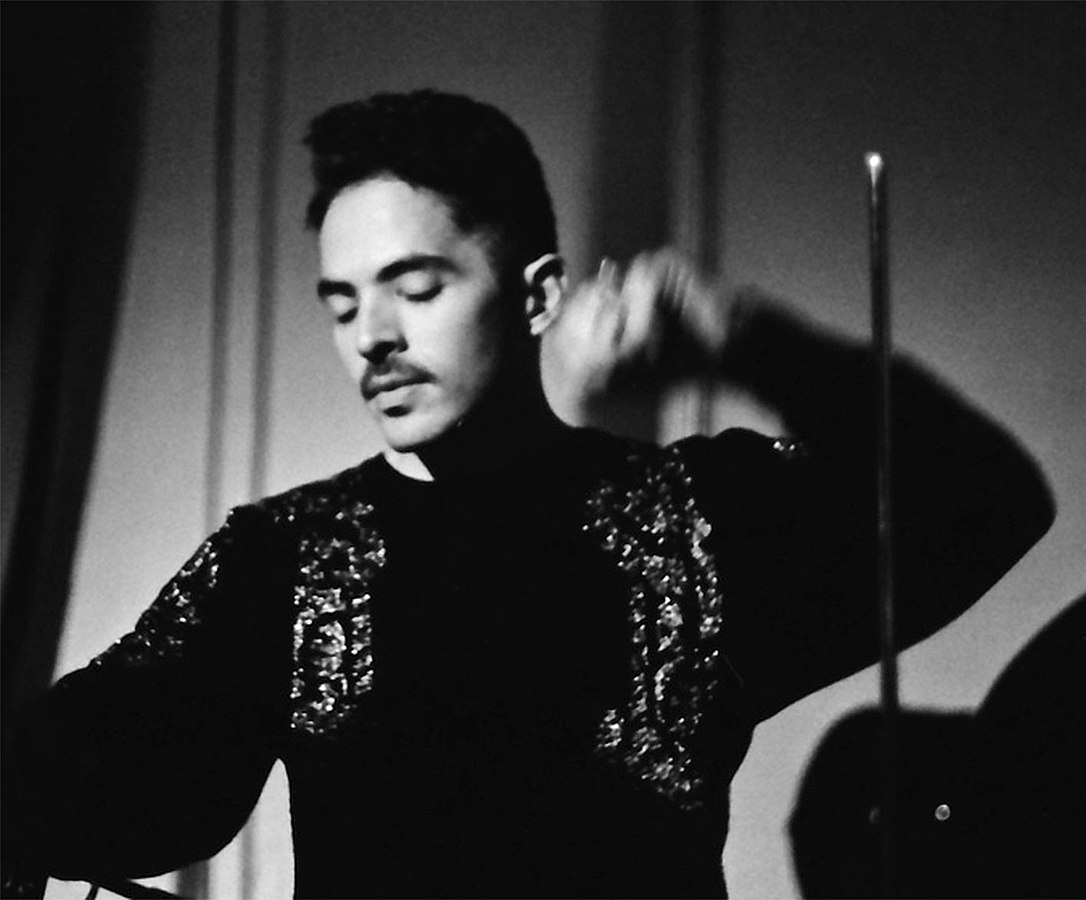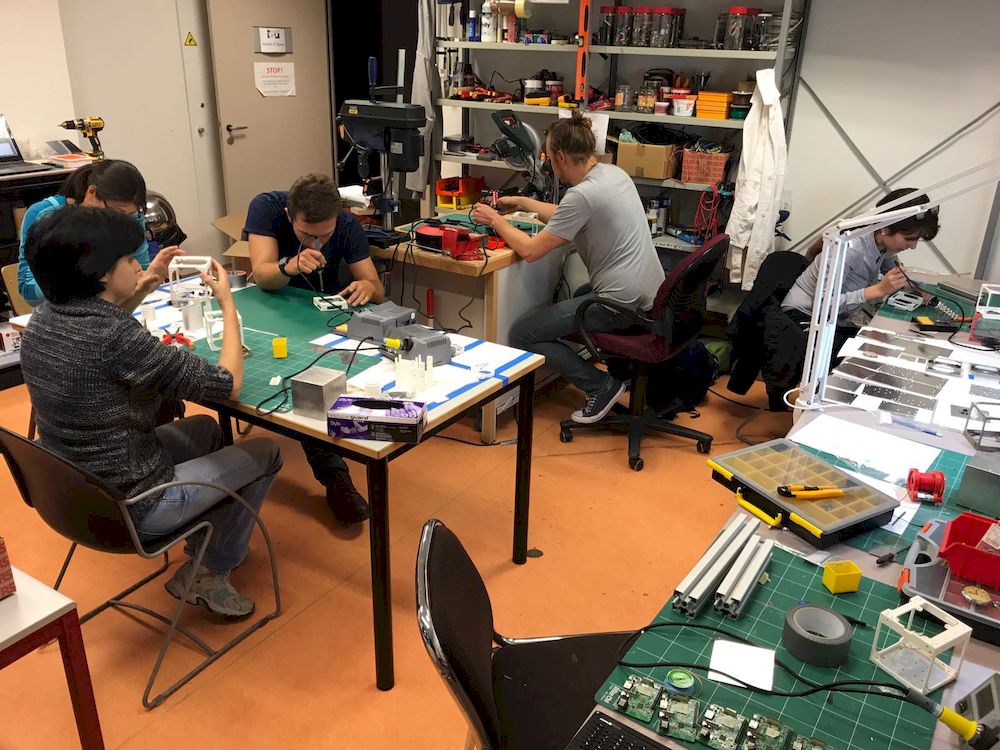“It’s official: I have an artwork in outer space“
Published 3 July 2018 by Ewen Chardronnet
On June 29, the Mexican artist sent an interactive artwork on board a SpaceX rocket to the International Space Station—a personal experience through a real-time manipulation protocol from Earth.
Mexican artist Nahum examines the relationships between magic, poetry and technology, plays theremin and performs as a hypnotist. Outer space being one of his favorite subjects, he launched in 2011 the Kosmica institute that organizes a festival in Mexico City and events touring around the world. At the International Space University (ISU) in Strasbourg, he conceived an artwork to test a new real-time manipulation system between Earth and scientific experiments at the International Space Station (ISS). The artwork, part of the SpaceX CRS-15 mission, was launched on June 29 from Cape Canaveral, Florida, on board a Falcon 9 rocket and a Dragon cargo module supplying the ISS. Makery invited Nahum to give a Medialab Makery talk about space at La Gaîté Lyrique in March. He shares more thoughts with us here.
IT’S OFFICIAL: I have an artwork in outer space. Today the #Dragon spacecraft launched successfully into the @Space_Station the heart of the artistic project The Contour of Presence in collaboration with @ICECubesService & @ISUnet More: https://t.co/ogqF9LgokQ #spaceart #art pic.twitter.com/jJh27EAeVt
— Nahum (@nahumartist) June 29, 2018
At Kennedy Space Center for the launch of a new artwork into outer space with Falcon 9 @SpaceX in collaboration with @ISUnet #sciart #art #spaceart #spaceculture pic.twitter.com/5h3SxoJL8J
— Nahum (@nahumartist) June 29, 2018
What does it mean to be an artist working in the space field?
I’m an artist, and I actually like to say just “artist” instead of performance artist or media artist, because the main focus of my work is the creation of poetics through any given medium. Even though I’ve done projects that are technologically and scientifically very demanding, it has always been clear for me that the end result is not science or technology, but simply art, and this could be either a performance, a video or an event. I am interested in giving focus to the meaning of a work rather than the medium used. In art-science projects, often the focus is on the method rather than the intentions of the work.

Take La Gravedad de los Asuntos (Matters of Gravity), a zero-gravity project where I invited a group of Mexican artists to work together on a series of artworks in a microgravity space mission at Star City, Russia, in 2015. It was clear to me that the underlying topic was that it was not a space mission. Initially I even wanted to have an exhibition where people wouldn’t even know where all those works were made or how it all happened. I wanted to see a series of artworks that deal with our cultural, physical and emotional relationship with a force that has shaped our bodies, our language, that has created the horizon and that we defy in dreams.
Presentation of “Matters of Gravity”:
What about “The Contour of Presence” project?
This project is happening as we speak because of a series of very fortunate and unlikely events. It’s been pure synchronicity with a fantastic group of collaborators and international space organizations that have worked really hard over two years to make this happen. This project started with the International Space University and Space Application Services to try a new system that allows interaction with payloads. We started working on an artwork that will use this technology for the very first time. I wanted to create something abstract and ethereal with no reference of scale or dimensions. I decided to create a kind of kaleidoscopic sculpture, with mirrors, lights and motors, all of which could be controlled from Earth. I liked the idea of framing this project as an encounter with this ethereal presence to examine what it means to be here and there. This was ideal for a one-to-one performance situation, but at the same time this could be an installation, with a story, and yes, a payload in space. So you, as a person, will enter a room, and first you will have to switch it on, this entity, that is circulating around you, around the Earth, and it will tell you a story, and it will ask you difficult questions about you. I like to say it will be a show that is about you, about what it means to be you, here, now, how you can exist, or not exist. In the end, it is a reflection of the politics of existence and how being here is not an individual affair.
It’s not the first time you’ve tackled intimacy in space…
Yes, when I was in zero-gravity I asked everyone in the flight to hug, and I made an artwork that sometimes makes people cry, it is very emotional. The first time I was in weightlessness, I realized that my body didn’t have any weight, that my body weighed nothing, I lost the sense of my materiality. So by embracing another human being, I could become aware of myself. I can only exist by embracing someone else. That shared existence is the message of this experience. So with this new project, it is also going to be intimate, because there is something beautiful about you being locked in a room with something orbiting and speaking to you in real-time. The audience will also be able to make decisions, and according to their decisions, the story is going to be different. Each person will have a very personal and intimate experience.
Time lapse of @SpaceX's recent launch showing a #noctilucent plume, where vapor condenses in the upper atmosphere, freezes into tiny crystals, and becomes backlit by sunlight. It tends to occur when launch is 30-60 mins before sunrise or after sunset. #CRS15 (Video: @SpacePharma) pic.twitter.com/3JPd0X1PfA
— Megs H. (@megsylhydrazine) June 30, 2018
How will the audience interact with the artwork?
People will be asked to do certain things, and it will react in real-time, and with a camera you’ll be able to see in real-time what is happening. It will be triggered by your behaviors and your decisions. The installation will have three screens that sometimes call you (“look at me, look at me, look at me”) in a kind of schizophrenic way, and depending which screen you look at, something different will happen. So it’s about composing an interactive narrative, an existential piece.
You want to keep it a mystery what will happen inside?
Yes, it’s like theatre, where I worked in for five years. When you see a play, you don’t want to know what will happen at the end. I do the same with my piece on hypnosis. People enter hypnosis and they make a trip to the Moon and see an Earth rise. That’s the “what”. But we all know that a show starts with an image, a poster, an article on the website, a text in a program. As an artist, you give them a bit of information, but not the whole story. The show starts with that, but the ultimate experience happens during the show.
“Evocations of a forgotten voyage”, hypnosis for a Moon trip, Nora Sotres Gallery, Mexico City, 2016:
How will the mission carry the payload?
This project is a collaboration between the International Space University, Space Applications Services’ ICE Cubes Service and Nahum Studios through a partnership with the European Space Agency. The actual payload was built at ISU under the supervision of Chris Welch, and some of their brightest students also contributed to its development. So we’ve been developing all the technology from zero, using rapid prototyping, 3D printing and laser cutting, and it was amazing that we could build the first prototype in a short period of time. Of course, it was more complicated for the final piece. We had to go through different tests, for vibrations, radiations, technical concerns and various assessments for all the electrical components. The artwork launched by SpaceX in Cape Canaveral will be installed by an astronaut. ESA is in charge of this part. After the mission, we’re going to get the artwork back to Earth, which is very rare. We hope it will be at the ISS for six months. During that period, it will be presented in museums in various countries.


So the real-time link is the innovative part of the project?
Yes, usually the astronauts install the payload, push a button, and that’s pretty much it. Then you have to wait for the results, which they bring back to Earth on a USB stick. With this technology, you will be able to see in real-time, change conditions, adjust variables, that’s why it is great for research. I am very humbled that one of the first payloads will be an artistic one. Real-time HD video link through Internet in my case.
After a gorgeous launch, the @SpaceX #Dragon #CRS15 will be arriving at @ISS_Research today at 7hEDT = 13hCEST bringing the 1st @ICECubesservice experiments of @ISUnet to their destination. Cheers to SpaceX for the ride! Images credit: SpaceX. Join in live https://t.co/RYSz57VF2q pic.twitter.com/kHZDOa7Hkc
— ICE Cubes (@ICECubesService) July 2, 2018
Team Hydra-3/Pulse at the @SpaceX CRS-15 launch – @nahumartist and bodyguards. pic.twitter.com/o4SxesbwqW
— Prof. Chris Welch (@ProfChrisWelch) June 29, 2018
It’s a “once-in-a-lifetime” invitation…
The first question I asked myself was “What would I like to see?” The second was “What kind of work haven’t I seen?” The answers: Something intimate, to offer a personal experience. I am not interested in thinking of being original or new—I don’t believe in the culture of “firsts”. But I do care about doing something enriching. A lot of art projects have been done in zero-gravity, but it was important to add a new chapter, to contribute in a different angle, and also because there were never Latin-American artists. I would love to see a space-art African mission, a women-only mission, a queer mission…works that come from unexpected angles. I always find it mind-blowing when I’m in front of an artwork, and it touches me on the physical level. When I have these kind of experiences, I remember why I decided to be an artist.
To know the dates and places (on Earth) of Nahum‘s installation “The Contour of Presence”
